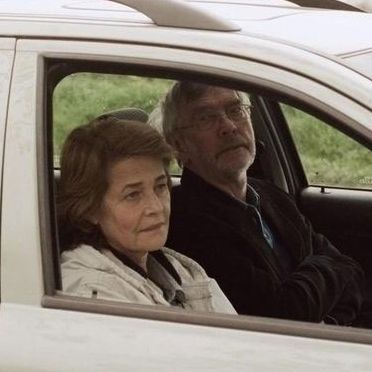
There comes a point in most long unions when one gazes at one’s mate and thinks, Who the fuck is this person? It might be prompted by a stray remark. Or it might be the discovery of something omitted from the person’s standard biography — which is what happens in the ruminative but potent drama 45 Years. Very early in the film, a retired English schoolteacher, Kate Mercer (Charlotte Rampling), learns that her husband of 45 years, Geoffrey (Tom Courtenay), had a deeper relationship than she’d realized with a girlfriend who’d died in a hiking accident before Kate and Geoff met. Before they met. Half a century ago. Why should it matter? Why, indeed.
Global warming — and the consequent melting ice — touches everything off. It’s a fine metaphor for a world in which every buried secret somehow rises to the surface. Or near enough to the surface. It was 1962 when a young German woman named Lena disappeared into an Alpine fissure, and it’s 2014 when her body is finally visible from a distance, looking much as she did at the instant she was frozen. Geoffrey was registered as next of kin, which is why he’s notified by post as he has his breakfast. But why was he next of kin when he was just her boyfriend? Kate mulls this over, asking a few questions at a time over several hours, days. (English people of a certain age tend to circle around things, taking pauses between questions. Hence, Pinter.)
Andrew Haigh (Weekend) adapted and directed 45 Years from a short story by David Constantine, and the changes Haigh made are illuminating. The story is told from the husband’s point of view and powered by his groggy awakening from the stupor of a long married life — a life under the ice, as it were. Haigh is on the side of Kate, the one who didn’t know the score and made all her choices in ignorance. She was a ravishing beauty of 19 when she married Geoffrey. They had no children. They don’t have many photos around their house and rarely allude to their past. It’s only because Kate has organized a lavish, 45th-year celebration of their marriage (Geoffrey was ill when they would have celebrated their 40th) that she’s thinking about Geoffrey’s courtship, their wedding, and the choices they made based on events of which she knew nothing.
It’s allusive, this movie. It has its longueurs. But it also has a kind of prickling dread, like a horror film in which ghosts show up or one spouse goes bonkers with a kitchen knife. No (spoiler), none of that happens. But when Kate pulls down the stairs to the attic and begins her ascent, the dog barks furiously, as if warning her not to go forward. And some of the photos and slides she finds are blurred, the way they are in Japanese ghost movies where the features of the dead are more frightening because you can’t quite make them out. And Courtenay’s performance is dotty in a way that makes you wonder if it’s a calculated dottiness, as if he’s using his age and infirmity as a mask to keep his true feelings out of sight. With all the talk of corpses under the ice and Irish bogs preserving Druid bodies, 45 Years is a horror-film manqué. It has been said (the source is lost in the mists of time) that the only way you could really know what’s in someone else’s head is if you bash in his or her skull and examine the brains.
For much of the film, Haigh’s camera rests on Rampling’s face as she stares out over fields and marshes, the only soundtrack the breeze or birds or distant bells from the village. Rampling still has every one of her histrionic resources, perhaps more than she had at the height of her glamour. Now she can present the mask and also show its cracks: tiny modulations of her smile that suggest uncertainty, a flicker of her eyes that signals inner panic. The movie has momentously disturbing ideas but a fine grain, its images suitable for framing — or hiding away in the attic.


